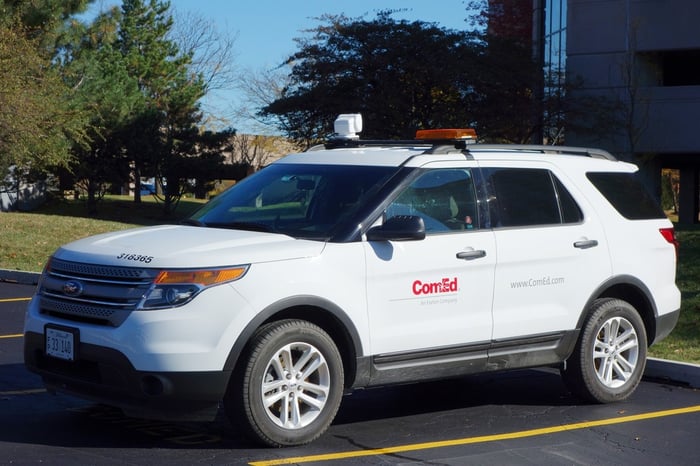Electrical Room and Infrastructure Requirements for Advanced Metering in Chicago

The Illinois utility Commonwealth Edison Company, better known as ComEd, has pledged to lead the way to a cleaner energy future in Chicago, as well as in every other city, town, and rural area in the state.

Picture of ComEd vehicle from Shutterstock.com
The utility’s top-notch smart grid network is at the forefront of this initiative, with its Advanced Metering Infrastructure (AMI) implementing a more advanced and energy-efficient electricity system. It is one of many Smart Grid Investment Grant (SGIG) projects that aim to modernize the electric grid and improve interoperability, as well as strengthen cybersecurity.
While smart meters and AMI installations are common to the entire country, the requirements for electrical room and advanced metering infrastructure in high-rise buildings in Illinois is controlled by a ComEd standard, C9114.
About the Advanced Metering Infrastructure
An integrated system that comprises communications networks, smart meters, and data management systems, AMI enables two-way communication between consumers and the utility, in this case, ComEd.
But it does more than this, adding functions that previously were either not possible or had to be undertaken manually. This includes the ability to:
- Remotely and automatically measure how much electricity has been used in a much more accurate manner.
- Detect if there has been any tampering, which lowers costs and helps to improve the collection of revenue.
- Identify and then isolate any outages that may have occurred, enabling repair crews to fix problems more quickly.
When AMI and customer systems are combined with in-home displays, communicating thermostats that can be programmed, and other forms of technology, utilities are also able to offer new time-based incentives and rates. These encourage consumers to better manage energy consumption which helps to reduce peak demand and cut costs.
Of course, smart meters are the core element of AMI, and the numbers that have been installed since the first pilot-scale SGIG projects were launched is substantial, and growing annually. By 2017, there were about 78.9 million AMI installations that, by definition, utilized smart meters. According to the U.S. Energy Information Administration’s (EIA) Independent Statistics & Analysis department, 88 percent of these were residential customers.
The U.S. Department of Energy’s Advanced Metering Infrastructure and Customer Systems Results from the Smart Grid Investment Grant Program published in September 2016 shows that customer services have improved and operational costs have been reduced. However, it also illustrates how complex the systems are for utilities to deploy AMI technologies.
Clearly, there are many challenges, and it is imperative for those installing AMI to do so in accordance with the requirements of their utility.
ComEd C9114 Standard for the Installation of AMI
Commonwealth Edison has been providing Northern Illinois with electricity services for more than a century. Its smart grid technology may be compared to smartphone technology because it uses wireless connectivity to operate.
Part of ComEd’sService and Meter Requirements 2018 Edition, the new C9114 standard details the AMI requirements for high-rise buildings.
The publication, issued by ComEd, is intended for anyone involved in the planning or construction of high-rise buildings, or in the installation or replacement of equipment that will be part of ComEd’s electric distribution system. In addition to the metering requirements covered by C9114, there are sections that cover:
- General services
- Overhead services
- Underground services
- Temporary services
- Lighting, specifically customer-owned outdoor lights
- Self-contained one-phase self-contained metering
- Self-contained three-phase self-contained metering
- Transformer rated metering that includes SCADA metering
In addition to the Standard, it is essential that the installations comply with the National Electrical Code and any other relevant local codes.
High-Rise AMI Requirements in Terms of the Standard
The AMI detailed in the Standard relates to meter and equipment rooms in buildings owned by customers of ComEd. It addresses both below-grade as well as many above-grade electrical equipment items and meter rooms to make certain ComEd’s AMI meters that are provided for customers are in fact on the electrical mesh network. All types of high-rise buildings are included whether they are commercial or residential.
A critical factor is that meters must communicate with one another and ultimately be able to access points using the ComEd mesh radio frequency (RF) network. The access points from the communications link effectively transfers the data from the meter back to ComEd.
In the Standard, ComEd specifies what must be provided by customers to facilitate the installation of ComEd’s AMI technology. This includes:
- Access for ComEd personnel who might be required to replace radio frequency equipment.
- Pathways, including conduit, that is required for the propagation of radio frequency signals.
- Installation of fire-stop systems required in accordance with local fire, building, or electrical codes.
- Installation of conduits in floors, ceilings, or walls, as specified in the applicable building code.
- Placement of conduit caps that are the same type and size as the conduit next to meter panels.
- Permanent installation of a termination enclosure with an accessible front cover on the outside wall of the building. The enclosure should be weather-tight and at least 12” x 10” x 6” in size with the conduit terminated inside the enclosure.
- The termination enclosure should be mounted to the surface of the wall or recessed, but it mustn’t be obstructed in any way by structures adjacent to the wall. It shouldn’t be any more than 25’ high and not less than 8’ above ground level. Roof locations for buildings that are 10 floors or higher require custom evaluation by ComEd.
- All conduit bends are required to have a radius of at least 12”.
A drawing of a typical high-rise building equipped with indoor electric meter rooms forms part of the Standard. The professional who is furnishing, installing, or maintaining the equipment is instructed to ensure:
- There is a clear wall space of 3’ x 3’ in each meter room so that the RF transceiver equipment can be installed, operated, or maintained. Additionally, the wall space must have an 18” clearance from any meter fittings or metallic equipment. Sometimes meter rooms are located directly above each other in which case wall space is only needed on every fifth floor.
- A 2-inch conduit is provided to connect each meter room to a common meter room. These conduits must be capped and it is essential they are vertically aligned from floor to floor. The caps must be of the same type and size as the conduit.
- A 2-inch conduit needs to be provided from the common meter room to the termination enclosure. This must be located on the outside of the building and 12” bends with a maximum total of 270 degrees in any one run should be used. More detailed instructions state that:
- Number 8 galvanized pulling wire, polypropylene rope, or nylong cord should be left in the duct.
- The duct should be temporarily sealed.
- Conduits should be less than 100’ long and the only openings allowed are in the electrical room.
- There should be no pulling points in conduits.
- If the building is 10 floors high or more, and a roof location is wanted, ComEd must be consulted for an evaluation.
- Ceiling lighting fixtures should be located not more than 10’ above the floor. The minimum lighting intensity is 10 footcandles which equal 110 lux measured at floor level.
Responsibilities of ComEd
In addition to the responsibilities of engineers and other professionals working on advanced metering systems in electrical rooms, ComEd will furnish, install and maintain certain elements. It is their responsibility to:
- Place ancillary RF equipment in room relays or access points.
- Undertake cable routing.
- Place and mount antennas.
Responsibilities of Engineers
Those planning or constructing high rise buildings in Chicago and other parts of Illinois must have a thorough understanding of the infrastructure requirements of advanced metering systems incorporated in electrical rooms.
New York Engineers has a team that not only has the experience and skills to handle electrical room infrastructure requirements but also the knowledge and experience to ensure that electrical rooms are designed and built to meet the wide series of requirements that make electrical installations work in high-rise buildings.

Ankit Javeri
Ankit is the Project Manager at NY Engineers, who holds an M.Tech. Some of his projects includes Community Access, Jackson Avenue
Join 15,000+ Fellow Architects and Contractors
Get expert engineering tips straight to your inbox. Subscribe to the NY Engineers Blog below.
